Deciphering the marking of Samsung TVs
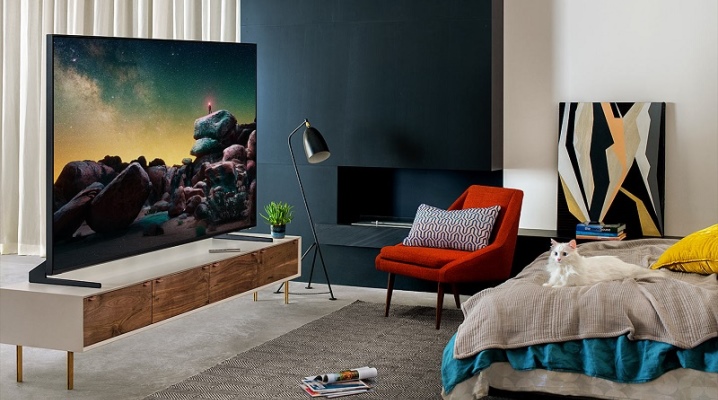
Samsung has been using a unified labeling system for its TVs since 2008. Previously, various options for encrypting parameters were used, but now you will not find television equipment released more than ten years ago in the trading network.

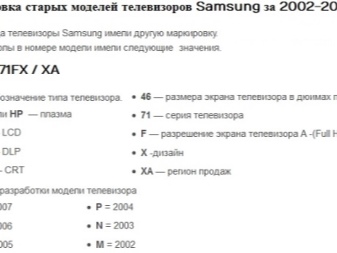
Peculiarities
Marking is a specific set of a combination of numbers and letters containing encrypted information about a product. This type of cipher can be seen on the packaging, on the back of the TV itself, or found in the menu.
What can the user learn about the purchased equipment, having carefully studied and deciphered the manufacturer's marking? This is mainly the date of manufacture of the product, the diagonal screen size, for which particular state or region it is intended, the model series. Please note that we are not talking about the serial number, but about the product series, which is characterized by certain technical parameters.
As a rule, the manufacturer informs in advance what functions and capabilities this or that series will have.
In addition, the marking code also includes the encoding of the country in which the sale of a particular TV model is provided. It has an alphabetic designation consisting of a combination of three uppercase characters of the English alphabet, for example:
- XRU - Russian Federation;
- XUA - Ukraine;
- XBT - Baltic States;
- XXE - Scandinavia;
- XXH - States of Eastern Europe.
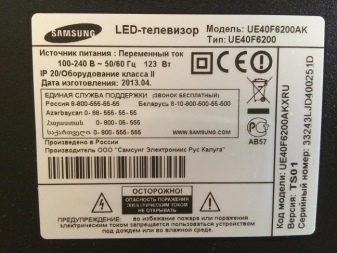

How do I know the screen layout?
To find out which type of TV screen belongs to, just look at the very first letter symbol in its marking. For example, Q is QLED. The LCD matrix, which uses quantum dot backlight technology, is a premium TV category. Also today, models are produced, the screen of which is made using other technologies, for example, U - a liquid crystal matrix with LED backlighting.
In earlier modifications, one could find the following screen encoding:
- TO - matrix based on organic LED elements;
- R - a plasma screen, but the production of "plasma" is currently discontinued;
- L - a matrix for the illumination of which fluorescent lamps are used, the use of this method in the production of TVs was completed seven years ago;
- WITH - kinescope - a television display based on the method of using cathode-ray tubes, familiar to domestic consumers from the first "Soviet" television sets.

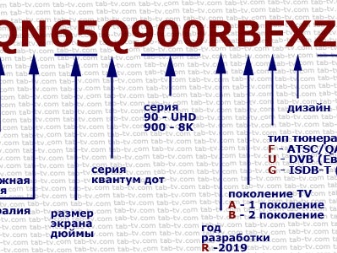
In addition, the screen may also differ in shape, which is also reflected in the marking code:
- F - flat surface;
- C - curved configuration.
- Since 2019, all of the company's TVs have a curved screen surface.
- Q - TV with QLED monitor;
- E - Europe - the continent on which sales are provided;
- 65 - standard size of the diagonal of the television display, measured in inches;
- Q9 - the digital parameter corresponds to the model series;
- 0 - modification numbering: single digit corresponds to 4K resolution, double - therefore, the resolution of the screen of this TV brand is 8K;
- R - 2019 is the date of production of television equipment;
- V - determines the generation of the lineup: B - the second (there is an HDMI 2.1 port and a modern console of the latest development), A - the first (there is no interface);
- U - type of tuner;
- XRU - The Russian Federation is the country where this model should be operated.
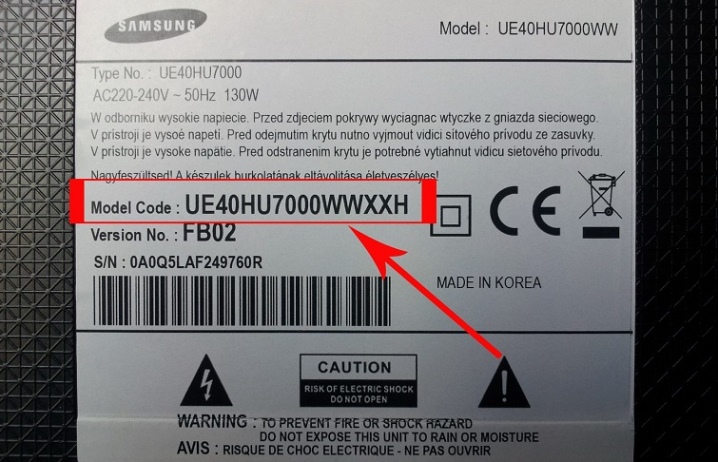
Continent marking
Continent is a geographic term that refers to the area of distribution of technology:
- E - European part;
- A - Asia-African region;
- S - Iran;
- N - America.
In the marking code, this is the second letter in a row. A simple example: in the UE65NS9000T labeling, "E" stands for the continent, namely Europe.
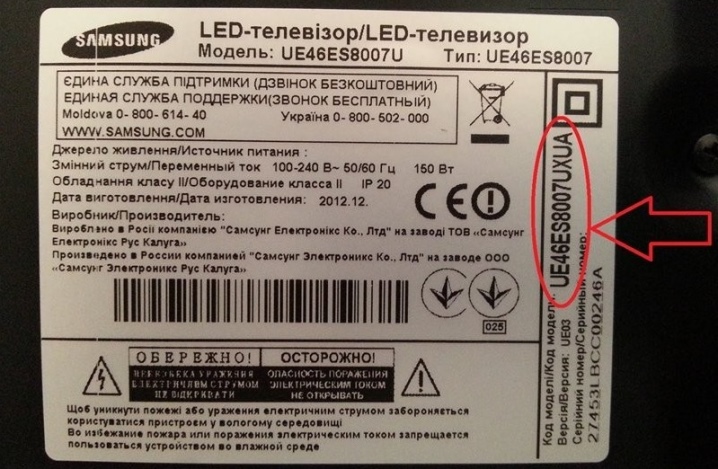
Size designations
In the marking code, after the first two letters, a couple of numbers follow, which allow the user to find out the size of the screen diagonal, but not in meters or centimeters, as usual, but in inches. An inch is a non-metric measure of length that is 25.4 mm.
The most popular among consumers all over the world are television monitors, the diagonal size of which ranges from 32 to 65 inches. The widest range of Samsung products includes television equipment with a larger diagonal, but it is intended for a large space with a large area and is not in particular demand.
In the entry on the UE55HU9000T TV plate, the symbol "55" stands for the diagonal length of the screen.
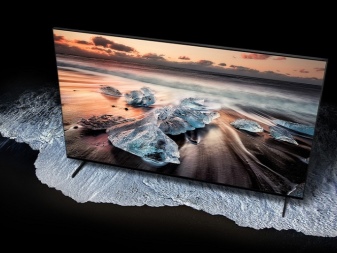
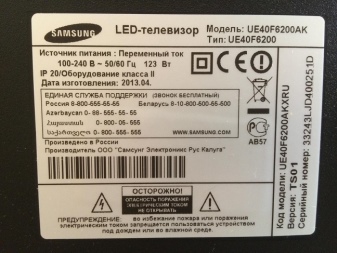
How do I know the year of issue?
The Korean company Samsung uses capital English letters to encrypt the year of production of its products. Each calendar period corresponds to a strictly defined letter in the order in which it follows in the alphabet or a letter combination:
- A - two thousand and eight;
- B - ... ninth;
- C - ... tenth;
- D - ... eleventh;
- E -… twelfth;
- F - ... thirteenth;
- HU / H - ... fourteenth;
- JS / JU -… fifteenth;
- KS / KU - sixteenth;
- Q / MU / M -… seventeenth;
- NU / N / Q * N - ... eighteenth;
- RU / R / Q * R -… nineteenth.
The letter combination Q * N or Q * R indicates that this is a premium QLED TV.
Additional alphabetic symbols following the production date indicate:
- U - ultra-high resolution 4K UHD screen;
- S - Marking for super-high-definition displays manufactured using quantum dot technology.
The TV model bearing the UE32F6800 marking was made in 2013, as indicated by the letter "F", which is located immediately after the number "32".
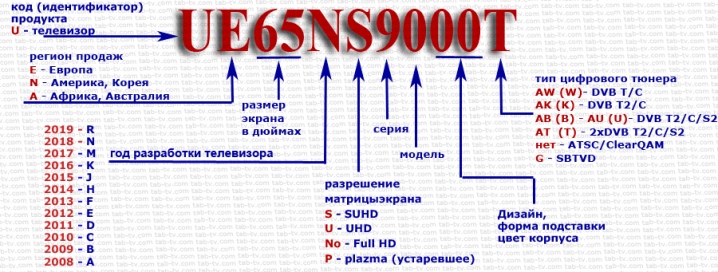
Previously, the release date was marked as follows:
- M - 2002;
- N - 2003;
- R - 2004;
- R - 2005;
- S - 2006;
- T - 2007.
And the marking itself could look like this: LN -T4671FX / XA, where: LN - LCD (liquid crystal matrix) - designation of the type of TV;
(You could also find such letter encodings indicating the type of TV:
- FP or HP - plasma;
- HL - DLP - technology for creating an image based on microscopic mirrors;
- CX - CRT - CRT-type models, for displaying the image on the display of which a CRT was used.)
- T - 2007 - the date the TV went on sale;
- 46 - screen size;
- 71 - TV series;
- F - screen resolution;
- X is a kind of design;
- HA - sales region.


Series indication
When coding a series of produced television devices, the Korean brand Samsung uses the digital range from 4 to 9. A large number always corresponds to the most modern models with the best technical and economic indicators and an expanded list of additional functions.
Let's briefly describe each.
- 4 - the original series, the model line of which has a relatively small screen diagonals in the range from 19 to 32 inches and HD resolution. The models have a dual-core processor and are equipped with built-in media players that allow you to watch videos over the network and from USB drives.
- 5 - this series is represented by models with a Full HD screen resolution, the diagonal length of which can range from 22 to 50 inches. All TVs have a network connection to a computer network or a wireless WI-FI connection.
- 6 - the latest generation of television equipment with the ability to view 3D images. The diagonal of the screen is usually in the range of 32-55 inches. The models have improved technology for displaying dynamic scenes, as well as the ability to connect to a computer or wireless network.
- 7 – these are premium models, in which the technology for displaying dynamic scenes has been improved significantly.Televisions are equipped with face recognition, voice or gesture control. Their diagonal size already ranges from 40 to 60 inches, and the processor is quad-core.
- 8 - differs from the "predecessor" in screen sizes up to 75 inches, an increase in the frequency of displaying dynamic scenes to 1000, the presence of the latest HBBTV function, which opens up additional interactive possibilities.
- 9 - the most perfect and sophisticated.
The model series and the serial number of the TV should not be confused - they are completely different things. The series is encrypted in the product label, the serial number is indicated on the nameplate, which is installed on the rear panel. It consists of fifteen characters - a combination of numbers and letters.
You can also see it by opening the "Support" section in the TV menu.
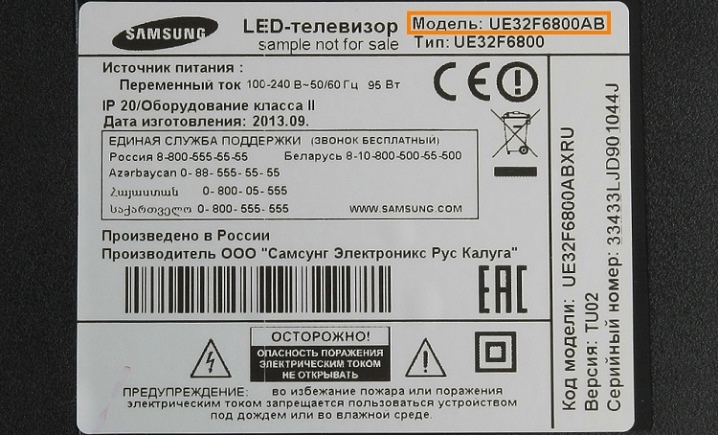
Tuner
The symbol ending in TV before the country code indicates the type of tuner. Previously, the presence and brand of the receiver was usually designated by a number.
- 0 - DVB-T - the very first version of receiver equipment capable of receiving a digital signal and transmitting a high-quality and clear image. The operation was carried out thanks to a conventional antenna.
- 7 - DVB-T2 - this is already the next level of decoder installations, characterized by increased channel bandwidth. Signal parameters and structure differ from the earliest versions. The formats of receivers of different generations are not compatible. On the territory of our country, this signal size is mainly used.
Currently, the type of the tuner in the marking is indicated by letters.
- AW (W) - DVB tuner with DVB-T (described above) and DVB-C functions. A widespread format that is used to decode the signal is the "digits" of cable television, but to use it, you must have a provider key card that can be installed in the slot.
- AB (B, AU or U) - DVB tuner with a set of functions DVB-T2, DVB-C and DVB-S2.
- SL - dual decoder 2 x DVB-T / C / S2 (code used in Europe).
- AF (BF) - DTV Tuner / Digital Cable Tuner / Analog Tuner - a type of receiver encoding in models, the implementation of which is provided in Mexico, China, Korea and the United Arab Emirates.

For information on the series and year of manufacture of your Samsung TV, see the following video.













The comment was sent successfully.